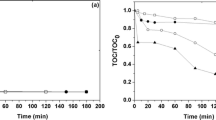Abstract
Ozone, chlorine and sodium hypochlorite are commonly used as disinfecting agents for drinking water production. The reaction pathways of ozonation and chlorination of o-methoxybenzoic acid in aqueous solution were studied using gas chromatography-mass spectrometry (GC-MS) and high pressure liquid chromatography (HPLC). The results show that less than 1% of o-methoxybenzoic acid remains in reaction. The final major products using ozone oxidation are oxalic and glyoxalic acids. Phenols appear only at insufficient ozone levels. Sodium hypochlorite leads to higher levels of primary products. Molecular chlorine leads to the formation of higher amounts of polychlorinated derivatives. Model experiments allow to propose schemes of o-methoxybenzoic acid transformation under the conditions simulating water treatment processes.


Similar content being viewed by others
References
Boyce SD, Horning JF (1983) Reaction pathways of trihalomethane formation from the halogenation of dihydroxyaromatic model compounds for humic acid. Environ Sci Technol 17:202–210
Hoigne J (1982) Handbook of ozone technology and applications. Ann Arbor Sci Publishers, Boston, pp 378
Lebedev AT, Moshkarina NA, Buriak AK, Petrosyan VS (1997) Water chlorination of nitrogen containing fragments of humic material. Fresenius Environ Bull 6:727–733
Lebedev AT, Shaidullina GM, Sinikova NA, Kharchevnikova NV (2004) GC-MS comparison of the behavior of chlorine and sodium hypochlorite towards organic compounds dissolved in water. Water Res 38:3713–3718
Rook JJ (1974) Formation of haloforms during chlorination of natural waters. Water Treat Exam 23:234–243
Rook JJ (1977) Chlorination reactions of fulvic acids in natural waters. Environ Sci Technol 11:478–482
Richardson SD, Thruston AD, Caughran TV, Chen PH, Collette TW, Schenck KM, Lykins BW, Rav-Acha C, Glezer V (2000) Identification of new drinking water disinfection byproducts from ozone, chlorine dioxide, chloramine, and chlorine. Water Air Soil Poll 23:95–102
Tretyakova NY, Lebedev AT, Petrosyan VS (1994) Degradative pathways for aqueous chlorination of orcinol. Environ Sci Technol 28:606–611
Yamamoto Y, Niki E, Shiokawa H, Kamiya Y(1979) Ozonation of organic compounds.2.Ozonation of phenol in water. J Organic Chem 44:2137–214
Author information
Authors and Affiliations
Corresponding author
Rights and permissions
About this article
Cite this article
Shaydullina, G.M., Sinikova, N.A. & Lebedev, A.T. Reaction of ortho-methoxybenzoic acid with the water disinfecting agents ozone, chlorine and sodium hypochlorite. Environ Chem Lett 3, 1–5 (2005). https://doi.org/10.1007/s10311-005-0103-1
Received:
Accepted:
Published:
Issue Date:
DOI: https://doi.org/10.1007/s10311-005-0103-1



